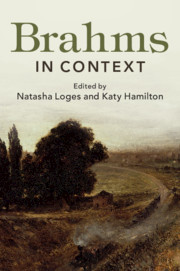Book contents
- Brahms in Context
- Brahms in Context
- Copyright page
- Dedication
- Contents
- Illustrations
- Music Examples
- Notes on Contributors
- Preface
- Abbreviations
- Part I Personality, People and Places
- Part II Identities, Environments and Influences
- Part III Performance and Publishing
- Part IV Society and Culture
- Part V Reception and Legacy
- Further Reading
- Index
- References
Part V - Reception and Legacy
Published online by Cambridge University Press: 15 May 2019
- Brahms in Context
- Brahms in Context
- Copyright page
- Dedication
- Contents
- Illustrations
- Music Examples
- Notes on Contributors
- Preface
- Abbreviations
- Part I Personality, People and Places
- Part II Identities, Environments and Influences
- Part III Performance and Publishing
- Part IV Society and Culture
- Part V Reception and Legacy
- Further Reading
- Index
- References
Summary
The reception of Brahms’s music beyond his home city of Hamburg began in 1853, when the young composer made his first extended journey and presented his compositions to some of the leading figures of German contemporary music: Robert Schumann, Robert Franz and Franz Liszt. Each reacted to these unpublished works in distinctive ways.
Robert Schumann, with whom Brahms spent the whole month of October in Düsseldorf,was instantly enthralled.
Keywords
- Type
- Chapter
- Information
- Brahms in Context , pp. 305 - 392Publisher: Cambridge University PressPrint publication year: 2019
References
Further Reading
Further Reading
Further Reading
The complete bibliographic information for all pre-2008 publications referenced in this article is in Platt, H., Johannes Brahms. A Research and Information Guide, 2nd ed. (New York: Routledge, 2011)



